Crossref Citations
This article has been cited by the following publications. This list is generated based on data provided by Crossref.
Liu, Feng
2023.
Balance of power, balance of alignment, and China’s role in the regional order transition.
The Pacific Review,
Vol. 36,
Issue. 2,
p.
261.
Ma, Xinru
and
Kang, David C.
2023.
Why Vietnam is not Balancing China: Vietnamese Security Priorities and the Dynamics in Sino-Vietnam Relations.
Journal of East Asian Studies,
p.
1.
Chan, Steve
2023.
Bewildered and Befuddled.
Asian Survey,
Vol. 63,
Issue. 5,
p.
691.






